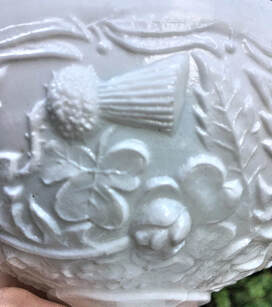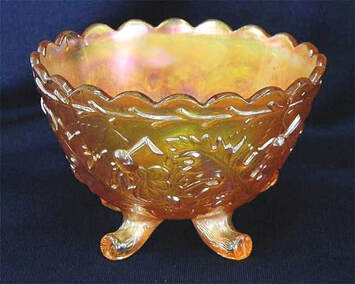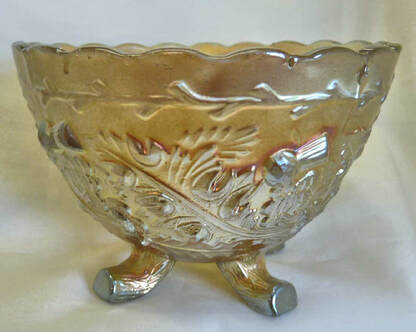Thistle and Thorn - maker not confirmed
Thistle and Thorn is probably one of the most mis-judged, mis-attributed and mis-understood Carnival patterns ever known.
|
So, let’s get the "elephant in the room" out of the way first. You’ll notice that we have written “maker not confirmed” – we have not offered an attribution of any kind. Yet all over the internet and in books, articles and more, this poor, mis-judged pattern gets attributed to Sowerby. There’s never any catalogue evidence provided in those so-called attributions, in fact no evidence ever shown at all – just a vague and dismissive “Sowerby” (we’ve even seen it attributed to “Sourby” – that left a bitter taste!). The spurious attribution to Sowerby simply gets copied and re-copied, from one supposed source to another, until it assumes a life of its own. We have even had people lecture us on the Sowerby attribution – it’s on the internet, it’s shown on eBay, so it must be true, right? Wrong. There is no evidence that Thistle and Thorn was made by Sowerby. The factory has been well researched and there are many catalogues to be studied. The Thistle and Thorn pattern is not there. Pattern We’ll address the thorny question of maker later – first let’s have a look at the pattern. The collector-given name of Thistle and Thorn implies two motifs, both of which are clearly evident (the “thorn” in the name refers to the encircling line, with its thorny, little offshoot branches around the top of the piece). What’s not acknowledged in the pattern name are the other two main motifs – the rose and the shamrock. But that’s understandable, as they are almost impossible to recognise within the moulded pattern. In an earlier version of a similar design (more about that later) it’s possible to pick them out clearly, which then enables us to spot them in the Carnival examples. The rose, thistle and shamrock are Royal heraldic symbols, representing the union of the United Kingdom. They were used on pressed glass in the 1800s – one in particular is of special interest. Made by Greener & Co. (Sunderland, England) you can see our sugar in white vitro-porcelain (milk glass) below. This stemmed sugar has the Greener mark inside – a lion with a five-point star – that dates it to between 1878 and the mid-1880s. |
Thistle and Thorn creamer, marigold.
|
And this is where our story gets interesting … as we can compare our 1800s sugar with our marigold Thistle and Thorn creamer, and see exactly what each motif was intended to be. The thistle is still clearly depicted on the marigold creamer, while the rose and shamrock are little more than blobs. But as soon as you look at the white sugar bowl and see the rose and shamrock, you can understand what the pattern on the Thistle and Thorn is actually meant to be.
|
Above: our Greener white vitro-porcelain sugar features the rose, thistle and shamrock in its design.
|
Above right: the 1800s pattern showing the thistle, shamrock and rose – and left, the later Thistle and Thorn version in marigold Carnival. Directly below the thistle on the marigold version, is the shape that was originally intended as a shamrock. Below that, on the right, is the shape intended to be the rose. Note also, how the wavy lines around the top on the early version have been simplified and reduced to the “thorny” line on the Carnival version.
|
It seems pretty clear that the Thistle and Thorn pattern was either derived from, or inspired by, the earlier 1800s concept. New moulds were almost certainly made for the Thistle and Thorn pieces, but they copied (rather sloppily) the earlier design concept. The Carnival items were mass-produced and cheap to buy. They are probably one of the most available patterns in the UK – reflecting the fact that they were clearly popular when they were made. And slight variations can be found in the pattern (some examples also have stippling) implying that a number of successive moulds were made – indicative of the popularity of these items when they were first made.
Shapes
Three main footed shapes are known in Thistle and Thorn – creamer, sugar bowl and low dish (shaped from the sugar).
The pattern is on the exterior, and each piece sits on four rustic feet – the handle on the creamer is also rustic in style. It’s worth pointing out that there’s quite a contrast between the size of the creamer and the rather large sugar! Just a splash of milk but plenty of sugar in your cup of tea, perhaps? The low dish was surely intended to be used for food. These were everyday items and surely would have brought a bright touch to many tables.
The pattern is on the exterior, and each piece sits on four rustic feet – the handle on the creamer is also rustic in style. It’s worth pointing out that there’s quite a contrast between the size of the creamer and the rather large sugar! Just a splash of milk but plenty of sugar in your cup of tea, perhaps? The low dish was surely intended to be used for food. These were everyday items and surely would have brought a bright touch to many tables.
|
Carnival Colours Marigold. Almost every piece ever seen is marigold – sometimes it’s deep and vibrant, sometimes it’s weak and hardly there, but mostly it’s somewhere between the two. A vast amount of these items must have been made. The sugar is also known in a curious, almost opaque base glass colour (shown, right) that has been variously described as aqua, pale blue, smoky or even green! Maker So, do we know which glass factory made Thistle and Thorn? Back in 2008, in our book “Carnival Glass The Magic & Mystery 2” we put forward our theory that the maker was possibly Greener & Co. at the Wear Flint Glassworks in the north east of England. We repeated that in our 2019 “Encyclopedia of European Carnival Glass”. The main evidence we have for this theory are the trademarked Greener items in the similar pattern (as shown above, in the form of the white sugar) and the fact that we know they used stannous chloride to iridise some goods (see “Magic and Mystery 2” for further information). Greener was actually taken over by James Jobling in the late 1800s (the name was changed to Jobling in 1921) but the Wear Glassworks remained an active business, producing domestic glassware which included supplying Woolworths. Based on the above, we feel it is possible that the Thistle and Thorn pieces were made at this glass factory in Sunderland – maybe from around the late 1920s, perhaps until as late as the 1950s. |
Thistle and Thorn sugar in a strange, almost milky,
hard-to-describe colour. |
Iridescent items are known from Greener-Jobling, in fact one Carnival item (Leaf and Grape) has a Greener registration mark. But we don’t have proof absolute. There is currently no catalogue evidence or similar, to definitively attribute Thistle and Thorn to Greener-Jobling at the Wear Flint Glassworks.
For now, without the final proof, we will say that Thistle and Thorn was possibly made by Greener-Jobling at the Wear Flint Glassworks in England.
(Note: others have copied our original 2008 analytical and tentative suggestion of Greener as the maker, but they have not included context or explanation, nor have they acknowledged us for putting forward the analysis).
References:
G&S Thistlewood “Carnival Glass The Magic & Mystery 2” 2008
G&S Thistlewood “Encyclopedia of European Carnival Glass” 2019






